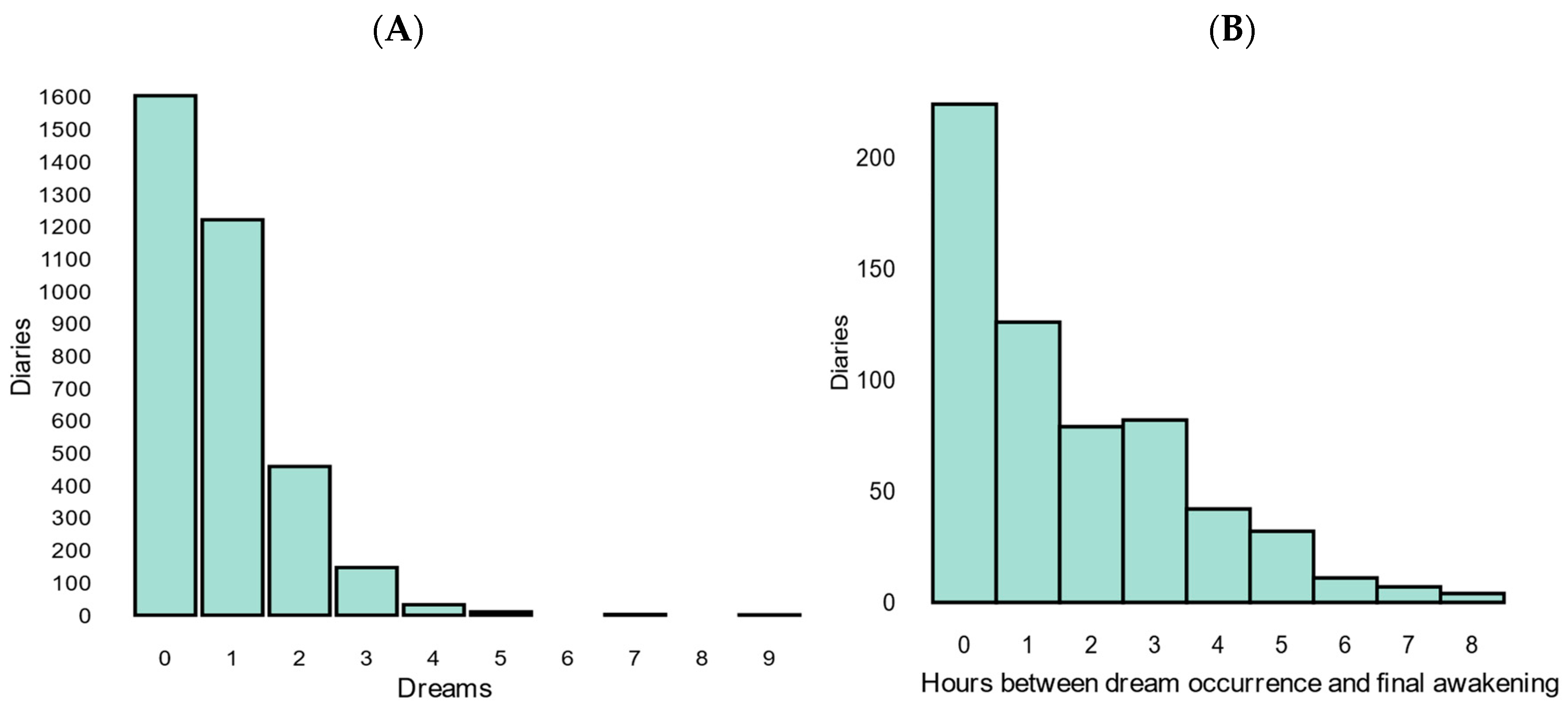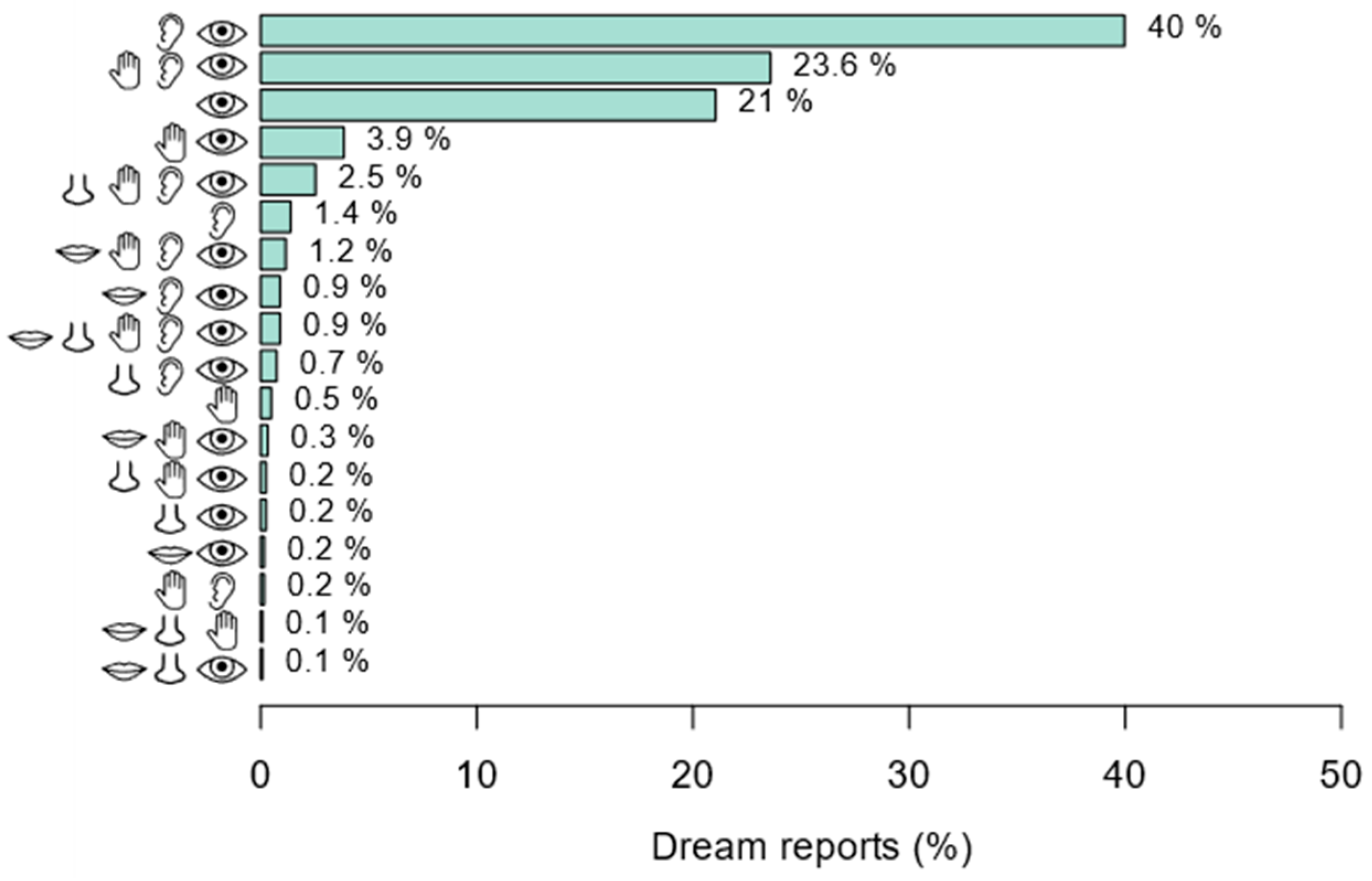Sensational Dreams: The Prevalence of Sensory Experiences in Dreaming
Abstract
1. Introduction
2. Materials and Methods
2.1. Sample and Procedure
2.2. Sensory Dream Diary
2.3. Statistical Analyses
2.3.1. Sensory Dream Experiences
2.3.2. Multisensory Dream Experiences
2.3.3. Link between Sensory Richness, Emotionality, and Clarity
3. Results
3.1. Demographics
3.2. Sensory Dream Experiences
3.3. Multisensory Dream Experiences
3.4. Sensory Rich Dreams Are Associated with Higher Emotional Intensity and Clarity
4. Discussion
5. Conclusions
Supplementary Materials
Author Contributions
Funding
Institutional Review Board Statement
Informed Consent Statement
Data Availability Statement
Acknowledgments
Conflicts of Interest
References
- Schredl, M.; Wittmann, L. Dreaming: A Psychological View. Schweiz. Arch. Neurol. Psychiatr. 2005, 156, 484–492. [Google Scholar]
- Schredl, M. Characteristics and Contents of Dreams. Int. Rev. Neurobiol. 2010, 92, 135–154. [Google Scholar] [CrossRef] [PubMed]
- Klepel, F.; Schredl, M.; Göritz, A.S. Dreams Stimulate Waking-Life Creativity and Problem Solving: Effects of Personality Traits. Int. J. Dream Res. 2019, 12, 95–102. [Google Scholar] [CrossRef]
- Wamsley, E.J.; Tucker, M.; Payne, J.D.; Benavides, J.A.; Stickgold, R. Dreaming of a Learning Task Is Associated with Enhanced Sleep-Dependent Memory Consolidation. Curr. Biol. 2010, 20, 850–855. [Google Scholar] [CrossRef] [PubMed]
- Van den Bulck, J.; Çetin, Y.; Terzi, Ö.; Bushman, B.J. Violence, Sex, and Dreams: Violent and Sexual Media Content Infiltrate Our Dreams at Night. Dreaming 2016, 26, 271–279. [Google Scholar] [CrossRef]
- Eichenlaub, J.-B.; Cash, S.S.; Blagrove, M. Daily Life Experiences in Dreams and Sleep-Dependent Memory Consolidation. In Cognitive Neuroscience of Memory Consolidation; Springer: Cham, Switzerland, 2017; pp. 161–172. [Google Scholar] [CrossRef]
- Wamsley, E.J.; Stickgold, R. Dreaming of a Learning Task Is Associated with Enhanced Memory Consolidation: Replication in an Overnight Sleep Study. J. Sleep. Res. 2019, 28, e12749. [Google Scholar] [CrossRef] [PubMed]
- Wamsley, E.J.; Stickgold, R. Memory, Sleep, and Dreaming: Experiencing Consolidation. Sleep Med. Clin. 2011, 6, 97–108. [Google Scholar] [CrossRef]
- White, G.L.; Taytroe, L. Personal Problem-Solving Using Dream Incubation: Dreaming, Relaxation, or Waking Cognition? Dreaming 2003, 13, 193–209. [Google Scholar] [CrossRef]
- Barrett, D. Dreams and Creative Problem-Solving. Ann. N. Y. Acad. Sci. 2017, 1406, 64–67. [Google Scholar] [CrossRef]
- Scarpelli, S.; Bartolacci, C.; D’Atri, A.; Gorgoni, M.; De Gennaro, L. The Functional Role of Dreaming in Emotional Processes. Front. Psychol. 2019, 10, 442641. [Google Scholar] [CrossRef]
- Zadra, A.L.; Nielsen, T.A.; Donderi, D.C. Prevalence of Auditory, Olfactory, and Gustatory Experiences in Home Dreams. Percept. Mot. Ski. 1998, 87, 819–826. [Google Scholar] [CrossRef] [PubMed]
- Snyder, F. The Phenomenology of Dreaming. In The Psychodynamic Implications of the Physiological Studies on Dreams; Charles C Thomas Publisher, Limited: Springfield, IL, USA, 1970; pp. 124–151. [Google Scholar]
- Yu, C.K.C. Dream Intensity Inventory and Chinese People’s Dream Experience Frequencies. Dreaming 2008, 18, 94–111. [Google Scholar] [CrossRef]
- Yu, C.K.C. Testing the Factorial Structure of the Dream Intensity Scale. Dreaming 2012, 22, 284–309. [Google Scholar] [CrossRef]
- Yu, C.K.C. Dream Intensity Scale: Factors in the Phenomenological Analysis of Dreams. Dreaming 2010, 20, 107–129. [Google Scholar] [CrossRef]
- Harmon-Jones, C.; Bastian, B.; Harmon-Jones, E. The Discrete Emotions Questionnaire: A New Tool for Measuring State Self-Reported Emotions. PLoS ONE 2016, 11, e0159915. [Google Scholar] [CrossRef]
- Carney, C.E.; Buysse, D.J.; Ancoli-Israel, S.; Edinger, J.D.; Krystal, A.D.; Lichstein, K.L.; Morin, C.M. The Consensus Sleep Diary: Standardizing Prospective Sleep Self-Monitoring. Sleep 2012, 35, 287. [Google Scholar] [CrossRef]
- R Core Team. R: A Language and Environment for Statistical Computing; R Foundation for Statistical Computing: Vienna, Austria, 2021. [Google Scholar]
- Mccarley, R.W.; Hoffman, E. REM Sleep Dreams and the Activation-Synthesis Hypothesis. Am. J. Psychiatry 1981, 138, 904–912. [Google Scholar]
- Fosse, M.J.; Fosse, R.; Hobson, J.A.; Stickgold, R.J. Dreaming and Episodic Memory: A Functional Dissociation? J. Cogn. Neurosci. 2003, 15, 1–9. [Google Scholar] [CrossRef] [PubMed]
- Foulkes, D.; Rechtschaffen, A. Presleep determinants of dream content: Effects o f two films. Percept. Mot. Ski. 1964, 19, 5–19. [Google Scholar] [CrossRef]
- Marti, J.M.; Andriano, D.W.; Mota, N.B.; Mota-Rolim, S.A.; Araujo, J.F.; Solms, M.; Ribeiro, S. Structural Differences between REM and Non-REM Dream Reports Assessed by Graph Analysis. PLoS ONE 2020, 15, e0228903. [Google Scholar] [CrossRef]
- Perogamvros, L.; Dang-Vu, T.T.; Desseilles, M.; Schwartz, S. Sleep and Dreaming Are for Important Matters. Front. Psychol. 2013, 4, 51581. [Google Scholar] [CrossRef]
- Martinec Nováková, L.; Kliková, M.; Miletínová, E.; Bušková, J. Olfaction-Related Factors Affecting Chemosensory Dream Content in a Sleep Laboratory. Brain Sci. 2021, 11, 1225. [Google Scholar] [CrossRef] [PubMed]
- Stevenson, R.J.; Case, T.I. Olfactory dreams: Phenomenology, relationship to volitional imagery and odor identification. Cogn. Personal. 2004, 24, 69–90. [Google Scholar] [CrossRef]
- Zhong, Y.; Jiang, R.; Zou, L. Do You Remember If You Have Olfactory Dreams? A Content Analysis of LOFTER and a Questionnaire Survey Conducted in China. Physiol. Behav. 2022, 252, 113849. [Google Scholar] [CrossRef] [PubMed]
- Noreika, V.; Valli, K.; Lahtela, H.; Revonsuo, A. Early-Night Serial Awakenings as a New Paradigm for Studies on NREM Dreaming. Int. J. Psychophysiol. 2009, 74, 14–18. [Google Scholar] [CrossRef]
- Picard-Deland, C.; Konkoly, K.; Raider, R.; Paller, K.A.; Nielsen, T.; Pigeon, W.R.; Carr, M. The Memory Sources of Dreams: Serial Awakenings across Sleep Stages and Time of Night. Sleep. 2023, 46, zsac292. [Google Scholar] [CrossRef] [PubMed]
- Carskadon, M.A.; Dement, W.C. Chapter 2-Normal Human Sleep: An Overview. Princ. Pract. Sleep Med. 2011, 5, 16–26. [Google Scholar]
- Feriante, J.; Araujo, J.F. Physiology, REM Sleep. In StatPearls [Internet]; StatPearls Publishing LLC: St. Petersburg, FL, USA, 2018; pp. 1–6. [Google Scholar]
- Siclari, F.; LaRocque, J.J.; Postle, B.R.; Tononi, G. Assessing Sleep Consciousness within Subjects Using a Serial Awakening Paradigm. Front. Psychol. 2013, 4, 55505. [Google Scholar] [CrossRef]
- Feinberg, I. Changes in Sleep Cycle Patterns with Age. J. Psychiatr. Res. 1974, 10, 283–306. [Google Scholar] [CrossRef]
- Pace-Schott, E.F.; Spencer, R.M.C. Age-Related Changes in the Cognitive Function of Sleep. Prog. Brain Res. 2011, 191, 75–89. [Google Scholar] [CrossRef]
- Vitiello, M.V. Sleep in Normal Aging. Sleep. Med. Clin. 2006, 1, 171–176. [Google Scholar] [CrossRef]
- Casagrande, M.; Forte, G.; Favieri, F.; Corbo, I. Sleep Quality and Aging: A Systematic Review on Healthy Older People, Mild Cognitive Impairment and Alzheimer’s Disease. Int. J. Env. Res. Public. Health 2022, 19, 8457. [Google Scholar] [CrossRef]
- Heft, M.W.; Robinson, M.E. Age Differences in Suprathreshold Sensory Function. Age 2014, 36, 1–8. [Google Scholar] [CrossRef] [PubMed]
- Heft, M.W.; Robinson, M.E. Somatosensory Function in Old Age. J. Oral. Rehabil. 2017, 44, 327–332. [Google Scholar] [CrossRef] [PubMed]
- Doty, R.L.; Kamath, V. The Influences of Age on Olfaction: A Review. Front. Psychol. 2014, 5, 72845. [Google Scholar] [CrossRef] [PubMed]
- Murphy, C.; Gilmore, M.M. Quality-Specific Effects of Aging on the Human Taste System. Percept. Psychophys. 1989, 45, 121–128. [Google Scholar] [CrossRef] [PubMed]
- Owsley, C. Aging and Vision. Vis. Res. 2011, 51, 1610–1622. [Google Scholar] [CrossRef] [PubMed]
- Roth, T.N.; Hanebuth, D.; Probst, R. Prevalence of Age-Related Hearing Loss in Europe: A Review. Eur. Arch. Oto-Rhino-Laryngol. 2011, 268, 1101–1107. [Google Scholar] [CrossRef]
- Schredl, M.; Reinhard, I. Gender Differences in Dream Recall: A Meta-Analysis. J. Sleep Res. 2008, 17, 125–131. [Google Scholar] [CrossRef]
- Murray, M.M.; Eardley, A.F.; Edginton, T.; Oyekan, R.; Smyth, E.; Matusz, P.J. Sensory Dominance and Multisensory Integration as Screening Tools in Aging. Sci. Rep. 2018, 8, 8901. [Google Scholar] [CrossRef]
- Hecht, D.; Reiner, M. Sensory Dominance in Combinations of Audio, Visual and Haptic Stimuli. Exp. Brain Res. 2009, 193, 307–314. [Google Scholar] [CrossRef] [PubMed]
- Meaidi, A.; Jennum, P.; Ptito, M.; Kupers, R. The Sensory Construction of Dreams and Nightmare Frequency in Congenitally Blind and Late Blind Individuals. Sleep. Med. 2014, 15, 586–595. [Google Scholar] [CrossRef] [PubMed]
- Okada, H.; Wakasaya, K. Dreams of Hearing-Impaired, Compared with Hearing, Individuals Are More Sensory and Emotional. Dreaming 2016, 26, 202–207. [Google Scholar] [CrossRef]
- Schredl, M.; Kälberer, A.; Zacharowski, K.; Zimmermann, M. Pain Dreams and Dream Emotions in Patients with Chronic Back Pain and Healthy Controls. Open Pain. J. 2017, 10, 65–72. [Google Scholar] [CrossRef]
- Doty, R.L. Olfactory Dysfunction in COVID-19: Pathology and Long-Term Implications for Brain Health. Trends Mol. Med. 2022, 28, 781–794. [Google Scholar] [CrossRef] [PubMed]
- Llana, T.; Mendez, M.; Zorzo, C.; Fidalgo, C.; Juan, M.C.; Mendez-Lopez, M. Anosmia in COVID-19 Could Be Associated with Long-Term Deficits in the Consolidation of Procedural and Verbal Declarative Memories. Front. Neurosci. 2022, 16, 1082811. [Google Scholar] [CrossRef]
- Hu, S.; Zhang, S.; You, Y.; Tang, J.; Chen, C.; Wang, C.; Wen, W.; Wang, M.; Chen, J.; Luo, L.; et al. Olfactory Dysfunction after COVID-19: Metanalysis Reveals Persistence in One-Third of Patients 6 Months after Initial Infection. J. Infect. 2023, 86, 516–519. [Google Scholar] [CrossRef] [PubMed]
- Saletin, J.M.; Goldstein, A.N.; Walker, M.P. The Role of Sleep in Directed Forgetting and Remembering of Human Memories. Cereb. Cortex 2011, 21, 2534–2541. [Google Scholar] [CrossRef]
- Feld, G.B.; Born, J. Sculpting Memory during Sleep: Concurrent Consolidation and Forgetting. Curr. Opin. Neurobiol. 2017, 44, 20–27. [Google Scholar] [CrossRef]
- Sara, S.J.; Poe, G.R. Sleep Is for Forgetting. J. Neurosci. 2017, 37, 464–473. [Google Scholar] [CrossRef]
- Langille, J.J. Remembering to Forget: A Dual Role for Sleep Oscillations in Memory Consolidation and Forgetting. Front. Cell Neurosci. 2019, 13, 439284. [Google Scholar] [CrossRef]




| Mean | SD | |
|---|---|---|
| Dream diary entries | 6.52 | 1.02 |
| Sleep quality | 3.50 | 0.93 |
| Total sleep time | 7:38 h | 1.28 h |
| Bedtime | 00:45 h | 01:39 h |
| Wake-up time | 08:41h | 01:42 h |
| Number of dreams | 0.80 | 0.74 |
| Dream clarity | 5.16 | 2.32 |
| Dream occurrence (prior to final awakening) | 01:39 h | 1:52 h |
| Dream retention interval (between dream occurrence and diary entry) | 02:43 h | 01:39 h |
| Diary entry interval (between waking up and diary entry) | 1:13 h | 2:16 h |
| Number of nightmares | 0.152 | 0.446 |
Disclaimer/Publisher’s Note: The statements, opinions and data contained in all publications are solely those of the individual author(s) and contributor(s) and not of MDPI and/or the editor(s). MDPI and/or the editor(s) disclaim responsibility for any injury to people or property resulting from any ideas, methods, instructions or products referred to in the content. |
© 2024 by the authors. Licensee MDPI, Basel, Switzerland. This article is an open access article distributed under the terms and conditions of the Creative Commons Attribution (CC BY) license (https://creativecommons.org/licenses/by/4.0/).
Share and Cite
van der Heijden, A.C.; Thevis, J.; Verhaegen, J.; Talamini, L.M. Sensational Dreams: The Prevalence of Sensory Experiences in Dreaming. Brain Sci. 2024, 14, 533. https://doi.org/10.3390/brainsci14060533
van der Heijden AC, Thevis J, Verhaegen J, Talamini LM. Sensational Dreams: The Prevalence of Sensory Experiences in Dreaming. Brain Sciences. 2024; 14(6):533. https://doi.org/10.3390/brainsci14060533
Chicago/Turabian Stylevan der Heijden, Anna C., Jade Thevis, Jill Verhaegen, and Lucia M. Talamini. 2024. "Sensational Dreams: The Prevalence of Sensory Experiences in Dreaming" Brain Sciences 14, no. 6: 533. https://doi.org/10.3390/brainsci14060533
APA Stylevan der Heijden, A. C., Thevis, J., Verhaegen, J., & Talamini, L. M. (2024). Sensational Dreams: The Prevalence of Sensory Experiences in Dreaming. Brain Sciences, 14(6), 533. https://doi.org/10.3390/brainsci14060533







